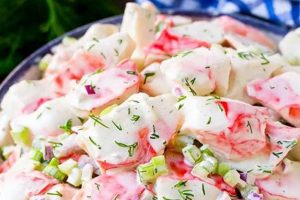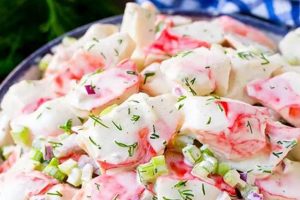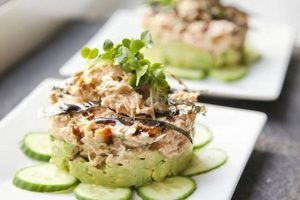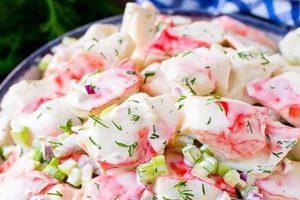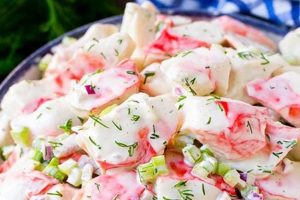A Crab Louie salad is a composed dish featuring Dungeness crab meat arranged atop a bed of crisp lettuce, often romaine, and accompanied by hard-boiled eggs, tomatoes, and a creamy Louie dressing. Variations may include asparagus, cucumbers, olives, or avocado. The dressing, typically a mayonnaise-based emulsion, is often seasoned with chili sauce, Worcestershire sauce, lemon juice, and spices. A well-executed preparation showcases the sweet, delicate flavor of the crab.
This iconic American salad, with roots potentially in San Francisco or Seattle at the turn of the 20th century, remains a popular choice for its refreshing nature and elegant presentation. Its enduring appeal lies in the harmonious balance of textures and flavors, from the richness of the crab and dressing to the crispness of the vegetables. The dish provides a good source of protein and, depending on the specific ingredients, can offer a range of vitamins and minerals.
Further exploration will delve into the nuances of ingredient selection, dressing variations, and techniques for achieving both classic and contemporary presentations of this culinary staple.
Tips for a Superior Crab Louie Salad
Achieving a truly exceptional Crab Louie salad requires attention to detail and an understanding of the interplay between ingredients. The following tips offer guidance for elevating this classic dish.
Tip 1: Prioritize Fresh, High-Quality Crab: Opting for fresh, preferably Dungeness, crab meat significantly impacts the overall flavor profile. Canned crab can be used, but ensure it’s of high quality and thoroughly drained.
Tip 2: Crisp Lettuce is Key: Use crisp romaine hearts or a combination of lettuces for optimal texture. Thoroughly wash and dry the leaves to prevent a soggy salad.
Tip 3: Perfect the Hard-Boiled Eggs: Properly cooked, firm yet not rubbery, hard-boiled eggs are essential. Avoid overcooking, which can cause a grayish yolk.
Tip 4: Dressing Consistency Matters: The Louie dressing should be creamy and smooth, not overly thick or runny. Adjust the mayonnaise and other ingredients to achieve the desired consistency.
Tip 5: Balance Acidity and Spice: The balance of lemon juice, chili sauce, and Worcestershire sauce in the dressing is crucial for a well-rounded flavor profile. Adjust these elements to personal preference.
Tip 6: Consider Ingredient Temperature: Serving the crab and other components chilled enhances the refreshing nature of the salad. Avoid using room-temperature ingredients.
Tip 7: Presentation Enhances Enjoyment: Arrange the salad components thoughtfully for an appealing visual presentation. Consider placing the crab meat atop the other ingredients rather than mixing it in. A garnish of fresh herbs or paprika can add an elegant touch.
By adhering to these guidelines, one can create a Crab Louie salad that showcases the delicate sweetness of the crab and the harmonious blend of flavors and textures.
With these essential tips covered, the subsequent sections will explore variations and adaptations of this classic dish, allowing for personalized interpretations while preserving its core essence.
1. Fresh Dungeness Crab
Fresh Dungeness crab holds a prominent position in the Crab Louie salad, significantly influencing the dish’s overall quality and authenticity. The sweet, delicate flavor and tender texture of Dungeness crab provide a distinct character that distinguishes the salad from versions using other crab varieties. Its inherent richness requires minimal seasoning, allowing the natural flavors to shine through the creamy Louie dressing and crisp vegetables. Choosing fresh Dungeness crab ensures a superior culinary experience, elevating the salad from simple fare to a celebration of Pacific Northwest cuisine. For example, a Crab Louie salad featuring freshly cooked Dungeness crab, purchased live from a local market, offers a noticeably brighter, more nuanced flavor compared to one using pre-cooked or frozen crab.
The importance of fresh Dungeness crab extends beyond flavor. Its moist, flaky texture contrasts beautifully with the other components, creating a harmonious interplay of textures. This contrast contributes to the salad’s appeal, offering a sensory experience that engages both palate and tactile senses. Furthermore, the visual appeal of large, pristine chunks of Dungeness crab enhances the presentation, contributing to a sense of luxury and indulgence. The use of inferior crab, often characterized by a stringy texture and a less vibrant flavor, can diminish the salad’s overall impact, highlighting the crucial role Dungeness crab plays in defining this iconic dish.
Understanding the significance of fresh Dungeness crab in a Crab Louie salad allows for informed decisions regarding ingredient sourcing and preparation. While alternative crab varieties may offer a more budget-friendly option, they often compromise the authentic flavor profile. Prioritizing fresh, high-quality Dungeness crab ensures a truly exceptional and memorable dining experience, reflecting the culinary heritage and regional specificity of this classic American salad.
2. Crisp Romaine Lettuce
Crisp romaine lettuce provides a foundational element in Crab Louie salad, contributing significantly to the dish’s textural complexity and overall enjoyment. The structural integrity of crisp romaine offers a sturdy base for the other components, preventing the salad from becoming soggy. Its slightly bitter flavor balances the richness of the crab and the creamy dressing, creating a harmonious flavor profile. Using limp or wilted lettuce compromises this balance, resulting in a less satisfying culinary experience. For example, a Crab Louie salad composed with crisp romaine maintains its structure and appealing presentation, even after being dressed, while a salad using less crisp lettuce becomes wilted and unappetizing.
The choice of romaine lettuce also impacts the salad’s visual appeal. The vibrant green hue of fresh romaine provides an aesthetically pleasing backdrop for the other ingredients, enhancing their colors and textures. The upright leaves create visual height and dimension, adding to the salad’s overall presentation. Conversely, using limp romaine diminishes the visual appeal, resulting in a less attractive and potentially less appetizing dish. Imagine a Crab Louie salad presented with vibrant, crisp romaine leaves; the visual impact alone elevates the dining experience. This contrasts sharply with a salad using wilted romaine, where the visual appeal, and potentially the perceived freshness, is compromised.
Selecting and preparing romaine lettuce correctly is crucial for optimizing the Crab Louie salad experience. Choosing romaine hearts, known for their crispness and tightly packed leaves, ensures structural integrity. Thorough washing and drying of the leaves prevents sogginess and maintains the desired texture. Proper storage techniques, such as refrigeration in a sealed container lined with paper towels, prolong the lettuce’s crispness. These practices demonstrate the practical significance of understanding the role of crisp romaine lettuce in creating a successful Crab Louie salad, highlighting its impact on both the sensory experience and overall presentation.
3. Classic Louie Dressing
Classic Louie dressing forms an integral part of a Crab Louie salad, acting as a unifying element that binds the various components and contributes significantly to the dish’s characteristic flavor profile. This creamy, piquant dressing, typically a mayonnaise-based emulsion, provides a rich counterpoint to the sweetness of the crab and the crispness of the vegetables. The balance of tangy acidity, derived from lemon juice or vinegar, and subtle spice, often from chili sauce and Worcestershire sauce, enhances the other flavors without overpowering the delicate crab. A Crab Louie salad without authentic Louie dressing, for instance, might feature a bland vinaigrette or a heavy, overly sweet dressing, failing to achieve the desired balance and diminishing the overall culinary experience.
The dressing’s consistency plays a crucial role in the salad’s overall texture and enjoyment. A properly emulsified Louie dressing clings lightly to the ingredients, coating them evenly without making the salad soggy. This allows each component to retain its distinct texture while contributing to the harmonious blend of flavors. A poorly made dressing, whether too thin or excessively thick, disrupts this balance. A thin dressing fails to adhere properly, while a thick dressing overwhelms the other ingredients, masking their individual flavors and creating an unpleasant, heavy texture. One can imagine the difference between a Crab Louie salad dressed with a perfectly balanced Louie dressing, where each bite offers a delightful interplay of flavors and textures, and a salad with a separated or overly thick dressing, where the individual components lose their distinct identities within a homogenous mass.
Understanding the critical role of Classic Louie dressing in a Crab Louie salad allows for informed decisions regarding its preparation and customization. While variations exist, adherence to the core principles of a balanced flavor profile and appropriate consistency ensures an authentic and enjoyable experience. Recognizing the dressing’s impact on both flavor and texture allows for nuanced adjustments tailored to individual preferences while preserving the essence of this classic American salad. Mastering the art of Classic Louie dressing elevates the Crab Louie salad beyond a simple assemblage of ingredients, transforming it into a cohesive and harmonious culinary creation.
4. Ripe, Juicy Tomatoes
Ripe, juicy tomatoes contribute a crucial acidic element to a Crab Louie salad, balancing the richness of the crab and the creamy dressing. Their vibrant color enhances the salad’s visual appeal, while their juicy texture provides a refreshing contrast to the other components. The selection of appropriate tomatoes directly impacts the overall flavor and sensory experience. Using underripe or mealy tomatoes diminishes the salad’s brightness and freshness. For example, a Crab Louie salad featuring ripe, in-season heirloom tomatoes offers a burst of sweetness and acidity that complements the crab, while a salad using flavorless, out-of-season tomatoes lacks vibrancy and can make the dish taste bland.
The quality of the tomatoes influences not only the flavor but also the structural integrity of the salad. Overly ripe or bruised tomatoes can release excess moisture, leading to a soggy salad. Careful selection ensures optimal flavor and texture, contributing to a more enjoyable culinary experience. Consider the difference between a Crab Louie salad made with firm, flavorful tomatoes that hold their shape and add a burst of juice with each bite, compared to a salad made with watery tomatoes that leach liquid and dilute the dressing, resulting in a less appealing presentation and compromised flavor.
Choosing the right tomatoes is essential for a successful Crab Louie salad. Ripe, flavorful tomatoes, such as vine-ripened or heirloom varieties, offer optimal flavor and texture. Avoiding overly ripe or bruised tomatoes prevents excess moisture and maintains the salad’s structural integrity. This understanding allows for informed selection and preparation, maximizing the tomatoes’ contribution to the overall balance and enjoyment of this classic dish. Attention to this detail, seemingly minor, demonstrates a commitment to quality and an appreciation for the nuanced interplay of flavors and textures that define a truly exceptional Crab Louie salad.
5. Perfectly Boiled Eggs
Perfectly boiled eggs constitute an essential component of a classic Crab Louie salad, contributing not only to nutritional value but also to textural and visual appeal. Their firm yet yielding texture offers a pleasing contrast to the other ingredients, while their visual presence adds a touch of elegance to the dish. The proper preparation of hard-boiled eggs is crucial for achieving the desired outcome; improperly cooked eggs can detract from both the aesthetic and culinary experience.
- Visual Appeal and Presentation
The contrasting colors and textures of the yolk and white contribute visual interest to the salad’s composition. A perfectly centered, bright yellow yolk, surrounded by a pristine white, enhances the overall presentation. Conversely, a discolored yolk with a greenish tinge, a common result of overcooking, detracts from the visual appeal and can signal a less-than-ideal flavor profile. Consider the difference between a Crab Louie salad garnished with evenly sliced, bright yellow yolks and one with dull, grayish yolks; the former elevates the presentation while the latter diminishes it.
- Textural Contrast and Balance
The firm yet yielding texture of a properly cooked egg provides a satisfying contrast to the other components of the salad. It complements the tenderness of the crab meat, the crispness of the lettuce, and the creaminess of the dressing. An overcooked egg, however, becomes rubbery and dry, disrupting the intended textural balance. Imagine biting into a Crab Louie salad and experiencing the harmonious interplay of textures, with the egg providing a pleasant firmness against the other elements. This contrasts sharply with the experience of encountering a rubbery, overcooked egg that disrupts the textural harmony.
- Nutritional Contribution and Flavor Enhancement
Hard-boiled eggs offer a valuable source of protein and essential nutrients, enriching the nutritional profile of the salad. Their subtle, slightly sulfurous flavor adds a nuanced complexity to the overall taste profile without overpowering the delicate sweetness of the crab. Overcooking, however, can intensify the sulfurous notes, resulting in an off-putting flavor that detracts from the overall culinary experience. The subtle richness of a perfectly cooked egg enhances the flavor profile without dominating it, a balance lost when the egg becomes overcooked and develops a strong sulfurous taste.
- Ease of Preparation and Culinary Technique
Achieving perfectly boiled eggs requires attention to detail and a precise cooking time. Proper techniques, such as starting with cold water, adding a pinch of salt, and avoiding a rolling boil, ensure consistent results. Overcooking, often the result of inattention or imprecise timing, leads to undesirable changes in texture and flavor. Consider the ease and efficiency of boiling eggs correctly from the outset, compared to the frustration and wasted ingredients resulting from overcooking. A simple process, executed correctly, contributes significantly to the success of the finished dish.
The seemingly simple inclusion of hard-boiled eggs in a Crab Louie salad demonstrates the attention to detail and culinary expertise required to elevate this dish beyond a mere combination of ingredients. The careful preparation and presentation of the eggs highlight their multifaceted contribution to the overall sensory experience, demonstrating their essential role in the creation of a truly exceptional Crab Louie salad. The interplay of visual appeal, textural contrast, flavor enhancement, and culinary technique underscores the significance of perfectly boiled eggs in this classic American dish.
6. Optional Avocado Slices
Avocado, while not a traditional component of Crab Louie salad, offers a complementary addition that enhances both flavor and textural complexity. Its creamy texture provides a counterpoint to the crisp lettuce and succulent crab, while its subtle, buttery flavor harmonizes with the richness of the Louie dressing. The inclusion of avocado introduces a healthy fat source, contributing to the salad’s nutritional value. However, avocado’s delicate nature requires careful handling and timely incorporation to prevent browning and maintain the salad’s fresh appeal. For example, adding perfectly ripe avocado slices just before serving a Crab Louie salad enhances the overall sensory experience, while using overripe or pre-sliced avocado can lead to discoloration and an unpleasant mushy texture, detracting from the dish’s visual and textural appeal.
The decision to include avocado in a Crab Louie salad depends on individual preferences and dietary considerations. While it enhances the salad’s richness and creaminess, it also alters the traditional flavor profile. Careful consideration of ripeness and proper handling techniques ensures that the avocado contributes positively to the overall culinary experience. Overripe avocado can overwhelm the delicate crab flavor, while underripe avocado lacks the desired creaminess. Furthermore, the inclusion of avocado introduces a perishability factor, impacting the salad’s shelf life. One can imagine the difference between a Crab Louie salad enhanced by the smooth, buttery flavor of perfectly ripe avocado and one marred by the oxidized, brown discoloration and mushy texture of poorly handled avocado. This illustrates the importance of mindful ingredient selection and preparation.
Understanding the implications of incorporating avocado into a Crab Louie salad allows for informed decisions regarding its inclusion and proper handling. While avocado can enhance certain aspects of the salad, its presence deviates from the traditional composition. Careful consideration of these factors ensures that the addition of avocado complements, rather than compromises, the intended balance of flavors and textures that define this classic American salad. The potential benefits and drawbacks highlight the importance of culinary judgment and a nuanced understanding of ingredient interactions in achieving a successful and satisfying culinary outcome.
7. Lemon Wedges
Lemon wedges serve a crucial, albeit often understated, role in a Crab Louie salad, contributing a bright, acidic counterpoint to the richness of the crab and the creamy dressing. Their presence extends beyond mere garnish; the fresh citrus juice enhances the other flavors, adding a layer of complexity and preventing the dish from feeling heavy. Understanding the multifaceted contribution of lemon wedges elevates appreciation for their inclusion in this classic salad.
- Flavor Enhancement and Balancing Acidity
A squeeze of fresh lemon juice brightens the overall flavor profile, cutting through the richness of the crab and the dressing. The citrus notes enhance the sweetness of the crab while balancing the other ingredients. The acidity also helps to preserve the vibrant colors of the salad components. For instance, adding fresh lemon juice to the Louie dressing itself provides a foundational layer of acidity, while a final squeeze over the assembled salad offers a burst of fresh citrus aroma and flavor just before consumption.
- Aromatic Lift and Sensory Experience
The aromatic oils released from the lemon peel when squeezed contribute a refreshing fragrance that elevates the sensory experience. This aromatic lift complements the visual appeal and textural complexity of the salad, creating a more engaging culinary experience. The act of squeezing the lemon wedge over the salad adds an element of interactive dining, further enhancing enjoyment. Imagine the burst of fresh lemon fragrance that permeates the air as a lemon wedge is squeezed over a Crab Louie salad, invigorating the senses and anticipating the bright, citrusy notes to follow.
- Visual Appeal and Presentation
The vibrant yellow color of lemon wedges adds visual appeal to the salad, contrasting beautifully with the other ingredients. Their presence elevates the presentation, adding a touch of elegance and freshness. Thoughtful placement of the lemon wedges enhances the overall composition, creating a more visually appealing dish. The visual cue of a lemon wedge suggests freshness and invites the diner to actively engage with the dish, personalizing the flavor experience.
- Preservation and Freshness
The citric acid in lemon juice acts as a natural preservative, helping to maintain the vibrant colors and fresh flavors of the salad ingredients, particularly the delicate crab meat. This contributes to the salad’s overall appeal and ensures that the flavors remain bright and vibrant even after a short resting period. This preservative quality allows the salad to be assembled slightly in advance without compromising its visual appeal or flavor profile, a practical consideration for entertaining or meal preparation.
The seemingly simple inclusion of lemon wedges in a Crab Louie salad belies their significant contribution to the overall culinary experience. From enhancing flavor and aroma to preserving freshness and elevating presentation, lemon wedges play a crucial role in creating a well-balanced and enjoyable dish. Their presence underscores the importance of considering every element in culinary composition, demonstrating how seemingly minor details can contribute significantly to the overall success of a dish.
Frequently Asked Questions
This section addresses common inquiries regarding the preparation and enjoyment of Crab Louie salad.
Question 1: What type of crab is traditionally used in Crab Louie salad?
Dungeness crab, prized for its sweet flavor and delicate texture, is the traditional choice. While other varieties can be substituted, they may not replicate the authentic flavor profile.
Question 2: Can canned crab be used?
Canned crab can be used, but its flavor and texture often differ from fresh. Opt for high-quality canned crab and ensure it is thoroughly drained before incorporating it into the salad.
Question 3: What is the significance of the Louie dressing?
The Louie dressing is integral to the salad’s identity. Its creamy, piquant flavor, typically derived from a mayonnaise base with chili sauce, Worcestershire sauce, and lemon juice, complements the crab and vegetables, creating a harmonious balance.
Question 4: How can sogginess be prevented?
Thoroughly drying the lettuce after washing and ensuring the dressing is properly emulsified helps prevent a watery salad. Adding the dressing just before serving also minimizes sogginess. Avoid using overripe or bruised tomatoes, which can release excess moisture.
Question 5: Can avocado be added?
While not a traditional ingredient, avocado can be added for a creamier texture and richer flavor. However, its inclusion deviates from the classic recipe and should be considered a variation. Use ripe, but not overripe, avocado and incorporate it just before serving to prevent browning.
Question 6: How long can Crab Louie salad be stored?
Crab Louie salad is best consumed immediately after preparation. If storage is necessary, refrigerate the components separately and assemble the salad just before serving. Avoid storing the dressed salad for extended periods, as the lettuce will wilt and the other ingredients may lose their freshness.
Understanding these aspects ensures a more informed approach to preparing and enjoying this classic dish. Careful attention to detail, from ingredient selection to proper handling, elevates the Crab Louie salad experience.
The following section will explore variations and adaptations of this iconic salad, offering further insights into its versatility and enduring appeal.
Crab Louie Salad
Exploration of Crab Louie salad reveals a dish defined by the harmonious interplay of fresh, high-quality ingredients. From the sweetness of Dungeness crab and the crispness of romaine lettuce to the creamy, piquant Louie dressing, each component contributes to a balanced and refreshing flavor profile. Proper preparation techniques, including the selection of ripe tomatoes, perfectly boiled eggs, and optional avocado, further enhance the sensory experience. An understanding of the historical context and regional significance underscores the enduring appeal of this American culinary icon.
Crab Louie salad offers a timeless culinary experience, adaptable to individual preferences while maintaining its core essence. Continued appreciation for fresh ingredients and careful preparation ensures the preservation of this classic dish for future generations. Its enduring popularity speaks to the timeless appeal of simple, yet elegant, cuisine.

